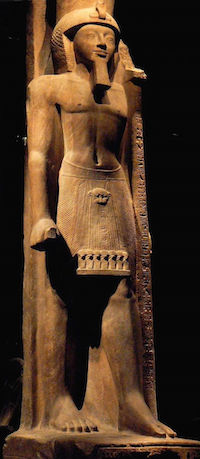Seti Merenptah (aka Sety Merenptah) ruled Egypt for a few years towards the end of the nineteenth dynasty (New Kingdom). He was the son of the pharaoh Merenptah and his Great Royal Wife Isetnofret II (who was the daughter of either Ramesses II or his son Khaemwaset).
It is very likely that he was the Crown Prince Seti Merenptah A who was depicted on many of the monuments of his father, confirming that he was always intended to succeed his father as pharaoh. However, his other family relationships are less clear.
He was definitely married to Tausret (who would become first joint and then sole ruler after his death), but he may also have been married to a woman named Takhat. If he was, then he may have been the father of the shadowy Amenmesse, who tried to usurp his throne. He was definitely the father of Seti Merenptah B (who died before his father) but he may also have been the father of his successor, Siptah. Alternatively, Siptah may have been the son of Amenmesse. We simply do not know.

It was originally thought that Amenmesse usurped the throne for a few years before Seti was able to wrest control from him. It is now considered more likely that Amenmesse only took control of Thebes and Upper Egypt during the third and fourth year of Seti’s reign while Seti retained control in the north. This is supported by the fact that work on Seti’s tomb (KV 15), halted after only a few years and the cartouches of Seti were removed. Shortly after, the cartouches were reinstated and work resumed – presumably when Seti took back Thebes. It is also notable that there are no references naming Seti in Upper Egypt year three or four.
Two papyri dating to the period may shed some light on the turbulent events. The first, the fictitious Tale of the Two Brothers, may be a satirical comment on the successional problems after the death of Merenptah. The second is the record of the trial of Paneb, one of the senior workmen of Deir el Medina. Paneb is accused of attempted murder, tomb robbery, rape, bribery, and corruption. The transcript certainly points to a breakdown in central authority.

Once he was back in control Seti set about destroying all trace of his rival, including removing his cartouches from Karnak and other sacred sites. He also took the unprecedented step of conferring the great honour of a tomb in the Valley of the Kings on both his Great Wife, Tausret and on his Chancellor, a Syrian named Bay. Perhaps he wished to honour them for their role in helping him retake the throne, or perhaps he felt the need to take measures to secure their loyalty.
He expanded the copper mines at Timna, building a temple to Hathor nearby. He also made some small additions to the temple complex of Kanak and is attested in inscriptions from Arithribis, Heliopolis, Serabit el-Khadim, Hermopolis, Aswan, Sehel, and Amada. However, he only managed to rule for a few short years.
His tomb (KV 15) had not yet been completed, so the plan was hastily amended with a corridor being converted into the burial chamber and many funerary objects being represented by poorly executed paintings on the tomb walls.
Pharaoh’s Names
- Horus Name: Kanakht Werpehti (Strong Bull, Great of Might)
- Prenomen: Userkheperure Setepenre (Powerful are the manifestations of Ra, chosen by Ra)
- Nomen: Seti Merenptah (One of Set, beloved of Ptah))
- Nebti: Nakht khepesh der pedjut 9 (Strong armed one who has repelled the nine bows)
- Golden Horus: Aaneruemtaunebu (He whose victories are great in all the lands)
Bibliography
- Brand, Peter J (2009) Usurped Cartouches of Merenptah at Karnak and Luxor from Causing his Name to Live: Studies in Egyptian Epigraphy and History in Memory of William J Murnane Edited by Peter Brand and Louise Cooper
- Dodson, Aidan (1999) “The decorative phases of the tomb of Sethos II and their historical implications” from The Journal of Egyptian Archaeology Vol. 85 pp. 131-142
- Dodson, A and Hilton, D. (2004) The Complete Royal Families of Ancient Egypt
- Dodson, Aidan (2010) Poisoned Legacy: The Fall of the 19th Egyptian Dynasty
- Dodson, Aiden (2016) The Royal Tombs of Ancient Egypt
- Van Dijk, Jacobus (2000) “The Amarna Period and later New Kingdom”, in The Oxford History of Ancient Egypt Ed I. Shaw
- Wilkinson, Richard H. Editor (2012) Tausret: Forgotten Queen and Pharaoh of Egypt
- Wilkinson, Richard H and Weeks, Kent Editors (2016) The Oxford Handbook of the Valley of the Kings
- Wilkinson, Toby (2010) The Rise and Fall of Ancient Egypt
Copyright J Hill 2018